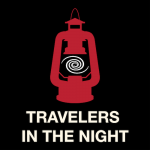Podcaster: Dr. Al Grauer

Title: Travelers in the Night 301E & 302E: WOW! What a Ride & Dangerous Comet
Organization: Travelers in The Night
Link : Travelers in the Night ; @Nmcanopus
Description: Today’s two stories:
- Richard Kowalski is at it again! He discovered the 508′ diameter 2016 XG1 which is a PHA, a Potentially Hazardous Asteroid
- The real impact danger to Earth comes from comets, not asteroids. A researcher at GSFC recommends we have spacecraft ready to intercept and deflect the dangerous impactor.
Bio: Dr. Al Grauer is currently an observing member of the Catalina Sky Survey Team at the University of Arizona. This group has discovered nearly half of the Earth approaching objects known to exist. He received a PhD in Physics in 1971 and has been an observational Astronomer for 43 years. He retired as a University Professor after 39 years of interacting with students. He has conducted research projects using telescopes in Arizona, Chile, Australia, Hawaii, Louisiana, and Georgia with funding from NSF and NASA.
He is noted as Co-discoverer of comet P/2010 TO20 Linear-Grauer, Discoverer of comet C/2009 U5 Grauer and has asteroid 18871 Grauer named for him.
Today’s sponsor: Big thanks to our Patreon supporters this month: Paul M. Sutter, Chris Nealen, Frank Frankovic, Frank Tippin, Jako Danar, Michael Freedman, Nik Whitehead, Rani Bush, Ron Diehl, Steven Emert, Brett Duane, Don Swartwout, Vladimir Bogdanov, Steven Kluth, Steve Nerlich, Phyllis Foster, Michael W, James K Wood, Katrina Ince, Cherry Wood, Brett Duane, Dmytro O
Please consider sponsoring a day or two. Just click on the “Donate” button on the lower left side of this webpage, or contact us at signup@365daysofastronomy.org.
Or please visit our Patreon page: https://www.patreon.com/365DaysOfAstronomy
Transcript:
301E – WOW What a Ride
Riding the surface of the asteroid that my Catalina Sky Survey teammate Richard Kowalski recently discovered would be an incredible experience.
When Richard first spotted this 508 foot diameter potentially hazardous space rock it was 50 million miles from him traveling away from the Earth at 15 miles per second towards the orbit of Jupiter. After he reported his discovery observations to the Minor Planet Center it was observed by telescopes in Arizona, New Mexico, England, and Germany and was given the name 2016 XG1. For the 8 months after Richard discovered it this asteroid will continue to move away from the Sun till on July 11, 2017 it will be more than half way to the planet Jupiter. After that it will begin to pick up speed on it’s breath taking plunge towards the Sun. After crossing the orbits Venus and Mercury, on July 31, 2018 it will round the Sun at an amazing 46 miles per second. At 2016 XG1’s closest approach to our star it will be receiving nearly twice the amount of solar flux which heats the surface of the planet Mercury to 800F. 2016 XG1 must be made out of very durable rocky material since it has made this incredible voyage many times in the past. Fortunately it never comes closer than about 16 times the Moon’s distance from us. This is a very good thing since a stony asteroid like 2016 XG1 strikes our planet every 150,000 years or so and inflicts major damage over a hurricane sized foot print on the Earth’s surface.
302E – Dangerous Comets
Every year, if we are lucky, several comets can come close enough for the Sun to warm and us to see the beautiful changing dust and gas clouds around them with binoculars or our unaided eyes. So far asteroids have gotten most of the attention as dangerous celestial neighbors, however, Dr. Joseph Nuth, a researcher at NASA’s Goddard Space Flight Center in Greenbelt, Maryland recently pointed out “Comets can also deliver a heaping helping of calamity to Earth, and scientists and policymakers alike should start taking measures to combat the threat”. Asteroid hunters are likely to spot a large incoming asteroid long before it before it becomes a threat.
Comets can come out of nowhere entering the inner solar system at a high rate of speed with little or no warning. Since humanity would not be given much lead time to deal with a deadly comet, Nuth suggests that we be ready with two spacecraft an “interceptor” and an “observer”. He feels that that these two vehicles should be ready so that if a threatening comet is discovered the “observer” could quickly be launched to make the measurements which would allow the nuclear weapon carrying “interceptor” to deflect the dangerous object which is on an impact trajectory with planet Earth. The same system could be used to deal with a large dangerous asteroid should one avoid detection by asteroid hunters and be about to strike with little advanced notice. The pair of space missions which Nuth proposes would cost less than a pair of high end military F-35 fighter jets, provide insurance against a comet strike, and teach us more about the world around us.
365 Days of Astronomy
=====================
The 365 Days of Astronomy Podcast is produced by Planetary Science Institute. Audio post production by me, Richard Drumm, project management by Avivah Yamani, and hosting donated by libsyn.com. This content is released under a creative commons Attribution-NonCommercial 4.0 International license. Please share what you love but don’t sell what’s free.
This show is made possible thanks to the generous donations of people like you! Please consider supporting our show on Patreon.com/CosmoQuestX and get access to bonus content. Without your passion and contribution, we won’t be able to share the stories and inspire the worlds. We invite you to join our community of storytellers and share your voice with listeners worldwide.
As we wrap up today’s episode, we are looking forward to unravel more stories from the Universe. With every new discovery from ground-based and space-based observatories, and each milestone in space exploration, we come closer to understanding the cosmos and our place within it.
Until next time let the stars guide your curiosity

